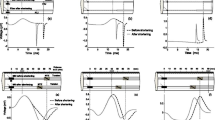Abstract
Single or small bundles of fibres were isolated from the abdominal myotomes of the sculpinMyoxocephalus scorpius, a teleost with a polyneuronal pattern of fast muscle innervation. Fibres responded to a supra-threshold stimulus with an all-or-none twitch. Tetanic fusion frequency at 3°C was 40–60 Hz, and the twitch tetanus ratio 0.70. Maximum isometric tension was 281 kN m−2. Similar isometric contractile properties were obtained from the focally innervated fast muscle fibres of another teleost, the eel,Anguilla anguilla. The response of sculpin fibres to stretch during tetanus was similar to that reported for frog twitch fibres. A 5% stretch of 25–50 ms duration increased force to 1.4P 0 which decayed to a steady level 5–10% above that of a control tetanus. The force-velocity relationship was also studied. Maximum contraction velocity was 4.75 Ls−1. Force-velocity data were not adequately described by a simple hyperbola. Alternative methods of curve fitting have been explored and discussed.
Similar content being viewed by others
References
Altringham JD, Johnston IA (1981) Quantitative histochemical studies of the peripheral innervation of cod (Gadus morhua) fast myotomal muscle fibres. J Comp Physiol A 143:123–127
Altringham JD, Johnston IA (1982) The pCa-tension and forcevelocity characteristics of skinned fibres isolated from fish fast and slow muscles. J Physiol 333:421–449
Altringham JD, Johnston IA (1986) Evolutionary adaptation to temperature in fish muscle cross bridge mechanisms: tension and ATP turnover. J Comp Physiol B 156:819–821
Barets A (1961) Contribution a l'etude des systemes moteurs lent et rapid du muscle lateral des teleosteens. Arch Anat Microsc Morph Exp 50 (Suppl):91–187
Bone Q (1964) Patterns of muscular innervation in the lowest chordates. Int Rev Neurobiol 6:99–147
Bone Q, Ono RD (1982) Systematic implications of innervation patterns in teleost myotomes. Brevoria 470:1–23
Brenner B (1980) Effect of free sarcoplasmic Ca concentration on maximum unloaded shortening velocity: measurements on single glycerinated rabbit psoas muscle fibres. J Muscle Res Cell Motil 1:409–428
Cecchi G, Colomo F, Lombardi V (1981) Force-velocity relation in deuterium oxide-treated frog single muscle fibres during the rise of tension in isometric tetanus. J Physiol 317:207–221
Colomo F, Lombardi V, Piazzesi G (1986) A velocity-dependent shortening depression in the development of the force-velocity relation in frog muscle fibres. J Physiol 380:227–238
Curtin NA, Woledge RC (1987) Force-velocity relation of living fibres from dogfish white muscle. J Physiol 387:46P
Edman KAP (1986) Further characterisation of the force-velocity relation in frog skeletal muscle. J. Physiol 377:92P
Edman KAP, Mulieri LA, Scubon-Mulieri B (1976) Non-hyperbolic force-velocity relationship in single muscle fibres. Acta Physiol Scand 98:143–156
Edman KAP, Elzinga G, Noble MIM (1978) Enhancement of mechanical performance by stretch during tetanic contractions of vertebrate skeletal muscle fibres. J Physiol 281:139–155
Edman KAP, Elzinga G, Noble MIM (1981) The critical sarcomere extension required to recruit force-enhancement during and after stretch in tetanic contractions of frog single muscle fibres. J Gen Physiol 78:365–382
Edman KAP, Elzinga G, Noble MIM (1982) Residual force enhancement after stretch of contracting frog single muscle fibres. J Gen Physiol 80:769–784
Flitney FW, Hurst DG (1978) Cross bridge detachment and sarcomere “give” during stretch of active frog's muscle. J Physiol 276:449–465
Flitney FW, Johnston IA (1979) Mechanical properties of isolated fish red and white muscle fibres. J Physiol 295:49–50P
Godt RE, Maughan DW (1977) Swelling of single muscle fibres of the frog. Experimental observation. Biophys J 19:103–116
Granzier HLM, Wiersma J, Akster HA, Osse JWM (1983) Contractile properties of a white and red fibre type of the m. hyohyoideus of the carp (Cyprinus carpio L.). J Comp Physiol 149:441–449
Gulati J, Podolsky RJ (1981) Isotonic contraction of skinned muscle fibres on a slow time base. Effects of ionic strength and calcium. J Gen Physiol 78:233–257
Hagiwara S, Takahashi K (1967) Resting and spike potentials of skeletal muscle fibres in salt-water elasmobranch and teleost fish. J Physiol 190:499–518
Hess A (1970) Vertebrate slow muscle fibres. Physiol Rev 50:40–62
Hill AV (1938) The heat of shortening and dynamic constants of muscle. Proc R Soc Lond B 126:136–195
Hudson RCL (1969) Polyneuronal innervation of the fast muscles of the marine teleostCottus scorpius L. J Exp Biol 59:47–67
Johnston IA, Altringham JD (1985) Evolutionary adaptation of muscle power output to environmental temperature: force-velocity characteristics of skinned fibres isolated from antarctic, temperate and tropical marine fish. Pflügers Arch 405:136–140
Julian FJ, Rome LC, Stephenson DG, Striz S (1986) The maximum speed of shortening in living and skinned frog muscle fibres. J Physiol 370:181–199
Lannergren J (1978) The force-velocity relation of isolated twitch and slow muscle fibres ofXenopus laevis. J Physiol 283:501–521
Lannergren J (1979) An intermediate type of muscle fibre inXenopus laevis. Nature 279:254–256
Marsh RL, Bennett AF (1986) Thermal dependence of contractile properties of skeletal muscle from the lizardSceloporus occidentalis with comments on methods for fitting and comparing force-velocity curves. J Exp Biol 126:63–77
Ono RD (1983) Dual motor innervation in the axial musculature of fishes. J Fish Biol 22:365–408
Videler JJ (1985) Fish swimming movements: a study of one element of behaviour. Neth J Zool 35:170–185
Westerfield M, McMurray JV, Eisen JS (1986) Identified motoneurones and their innervation of axial muscles in the zebrafish. J Neurosci 6:2267–2277
Woledge RC (1968) The energetics of tortoise muscle. J Physiol 197:685–707
Author information
Authors and Affiliations
Rights and permissions
About this article
Cite this article
Altringham, J.D., Johnston, I.A. The mechanical properties of polyneuronally innervated, myotomal muscle fibres isolated from a teleost fish (Myoxocephalus scorpius). Pflugers Arch. 412, 524–529 (1988). https://doi.org/10.1007/BF00582542
Received:
Revised:
Accepted:
Issue Date:
DOI: https://doi.org/10.1007/BF00582542




